4-Person Group Project
Skills:
Conceptualization, Prototyping, User Research, Programming, Graphic Design
Tools:
Adobe Photoshop, Illustrator, Indesign, Arduino, Premium
Duration:
2015.02 - 2015.06
Have you ever had that situation; you’re watching a movie in the living room with the light dimmed. Suddenly, your roommate walks in and turns the light bright because he needs to study. Wouldn’t it be great if everybody in the room would be able to adjust the light matching their own preferences?
Systema Luz is the solution. Each light in the room can be individually controlled and set by turning the rings. You have the option to choose up to 4 settings at a time. Each light can then be easily controlled and set to your preferred setting. You can even make your own light groups to allow for easy setting switching. This product allows everybody to have maximum control over the lights in a room.
Systema Luz. Give it a spin and turn the lights around!
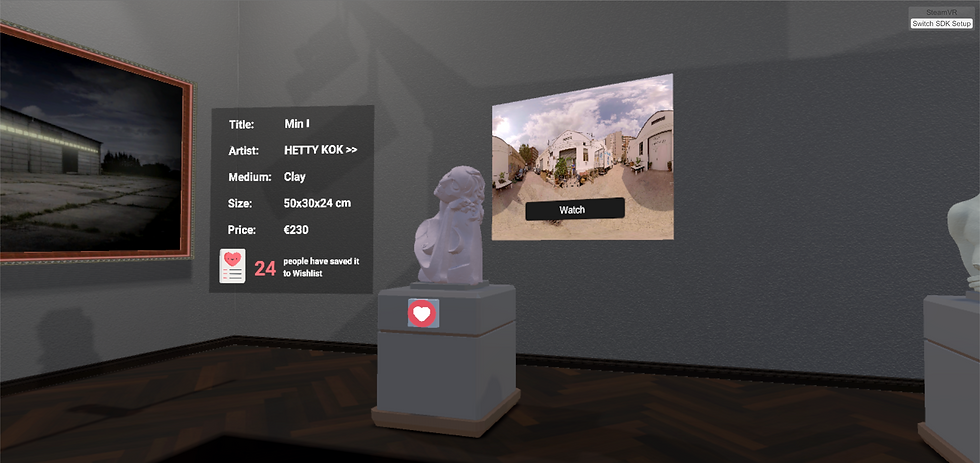
VR Gallery
In order to attract a broader audience and encourage the user group to buy artworks after visiting a gallery, this project aims to create a new gallery concept combining the physical and the virtual dimension. The main objective of this project is to use Virtual Reality to enhance the current art experience and encourage the purchases, by designing intuitive interactions between the viewer and the virtual art gallery.
My Role
This was my Final Master Project in TU Delft. It was an individual project, so I acted as a project manager, user experience researcher and designer, communicator and final presenter.
Clients
TU Delft
Galerie Hilversum
Goois Scheppend Ambacht
Sonolux
Project Type
User Research, Interactive Design
Duration
Apr 2019 - Nov 2019
Team
Individual
Tools
Unity, Adobe Creative Suites
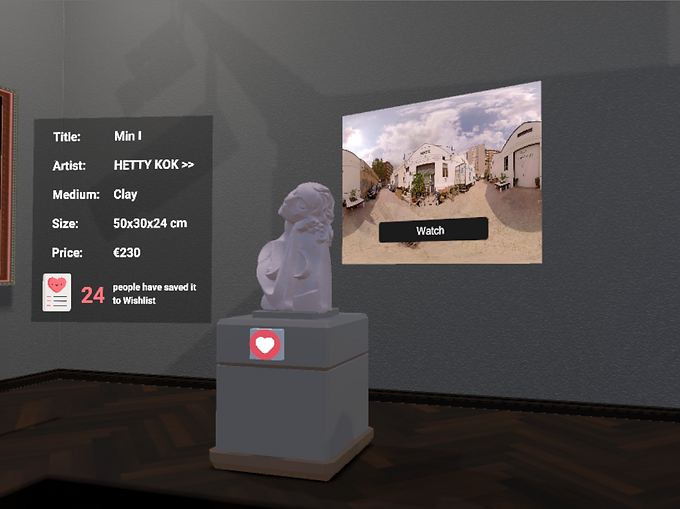
The Challenge
This project was to develop a new gallery experience, which includes VR technology to bring the art of independent small art collectives to a broader audience, and to encourage purchases.
This was associated with an artists' collective called “GSA” (Goois Scheppend Ambacht) and Galerie Hilversum. Due to fewer customers in recent years, Galerie Hilversum was closed in 2017, they approached to set up this project to improve the current situation of the artists.
The Process
A glimpse on the final work :)
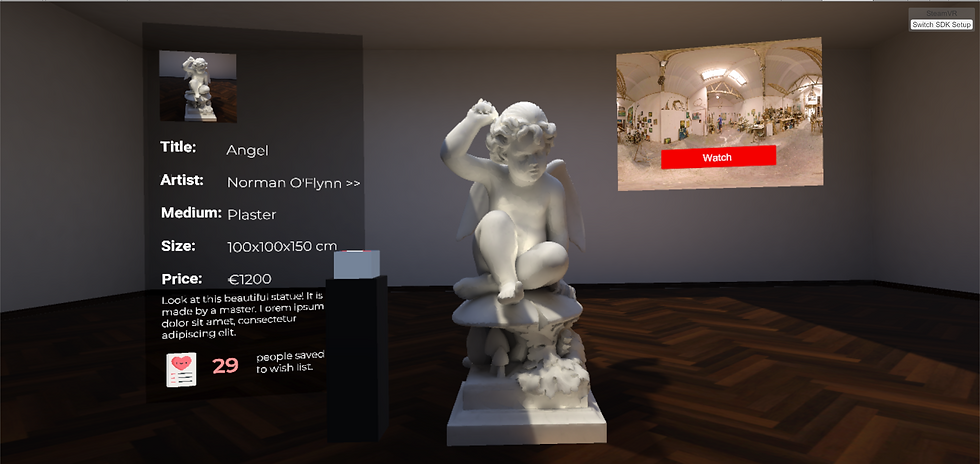
1. Introduction
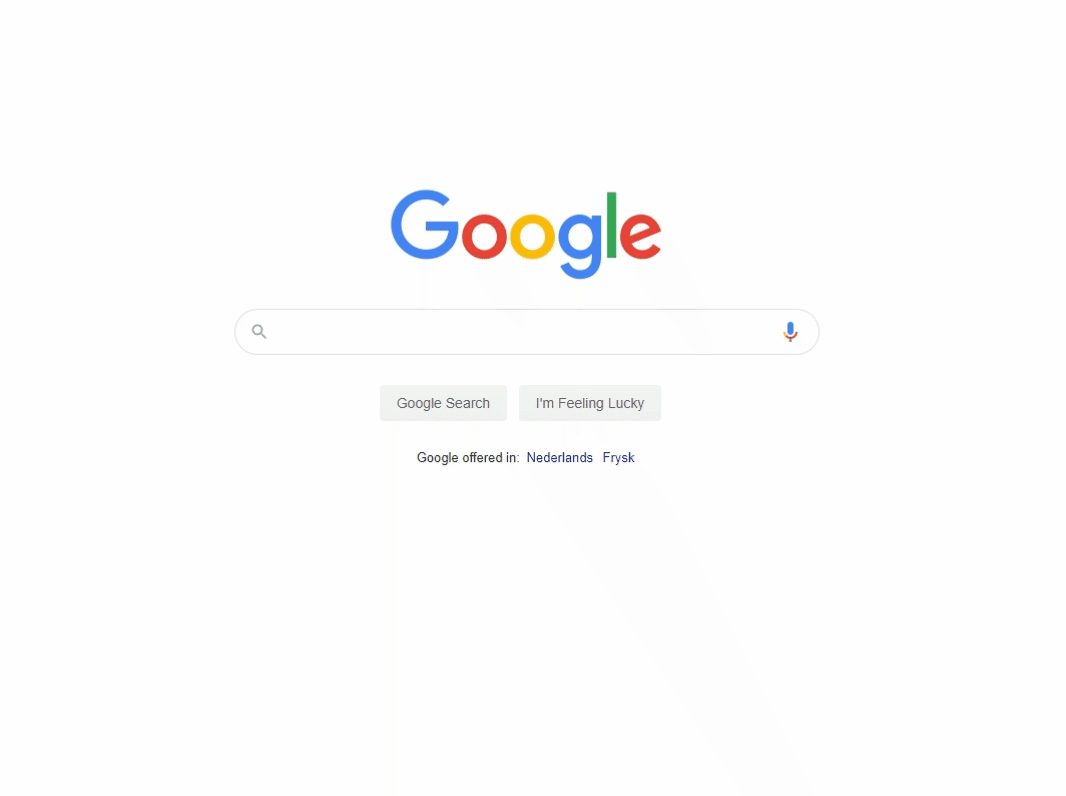
Hundreds years ago, gallery was an important place for people who want to get touch with arts.

Nowadays, young customers have so many options to engage in art, visiting a gallery became their last few options when talking about art. Apart from that, art market hasn’t found a good way to go online in this digital era. Because of these, more galleries are closed due to the fewer customers.
Therefore, this project wants to develop a new gallery experience that includes VR technology to bring the independent small art collectives to a broader audience and to encourage purchases.
Main Problem
Younger customers has too many alternative options rather than visiting a gallery.
Art market hasn’t find a good way to go online in this digital era.
More galleries are closed because of fewer customers.
Design Goal
Developing a new gallery experience that includes VR technology to bring the independent small art collectives to a broader audience and to encourage purchases.
2. Analysis
The analysis phase consists of researching on three aspects: human, technology, and business. Different methods were used to obtain results from different perspectives.

Analysis Strategy
Methods Used
Literature reviews
Contextual inquires
Interviews
Emotion Capture Cards
Storyboard
Business canvas
Customer journey
2.1. Research on Human aspect
During the research on human aspect, I interviewed several artists from the GSA. Apart from that, I went to several galleries in Den Haag. From the observation, a storyboard was drawn.
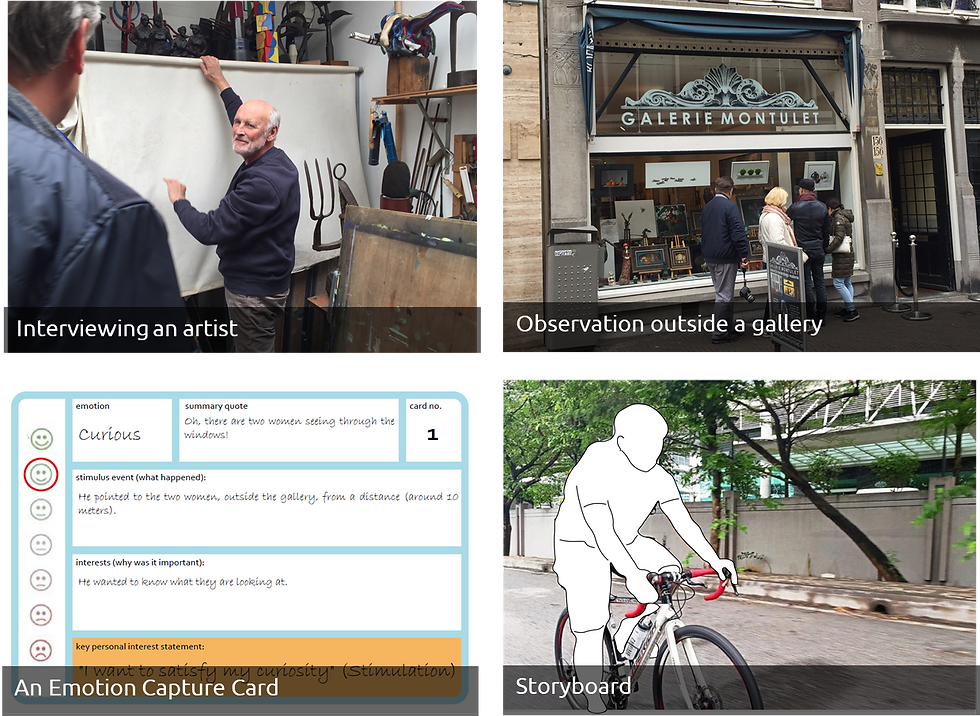

Currently, people may search on the internet to explore interesting places and travel to the desired gallery. But the experience often starts with the third picture. They see the gallery on the street and start glancing through the windows. Then they go inside and browsing around to see different artworks. After that, they leave the gallery. People often stay in a gallery for a very short time, less than 5 minutes.
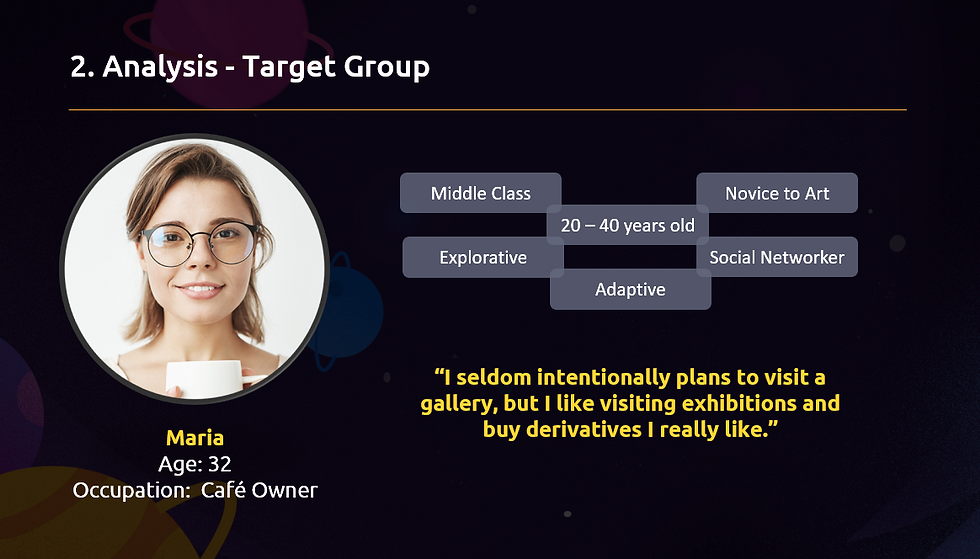
From the research, a user profile was pictured. This is Maria, age 32. and she is a café owner. Her experience on gallery is “she seldom intentionally plans to visit a gallery, but she likes visiting exhibitions and buy derivatives she really likes.” I was targeting the middle-class people, normally aged between 20 to 40 years old. They are novice to art, but they are explorative and adaptive. Besides, they are normally social networker. Who likes to share experience with their friends.
2.2. Research on Technology aspect
To build a VR gallery, we also need to digitize the artworks from the artists. From the analysis, I made a diagram based on purchase preference and difficulties of 3d scanning. From the diagram we will focus on painting and drawings, and sculptures with distinct shapes.

2.3. Research on Business aspect
A modern customer journey was drawn to check what the gallery could do to improve the experience in different stages. For example, current gallery is lack of post-purchase experience, so we can think what we can provide to the customers even after their purchase, so they will return and became a loyal customer.

Desired Experience
From the analysis, I envisioned that the envisioned new gallery will offer a more approachable way of visiting a gallery. The novice art buyers should feel comfortable to enter the café-like gallery, where they can explore different forms of interactions with VR HMD devices to have continuous stimulation. Furthermore, after the experience, they should be motivated to spread the word. They should be offered possibilities to schedule next visit or glancing desired artworks online.
The detailed of the design requirements can be found in the report.
3. Conceptualization
From the desired user experience, I have three key elements wanted to integrate in the final concept, which is approachable, emotions and purchase. Therefore, three concepts were created focusing on each element.
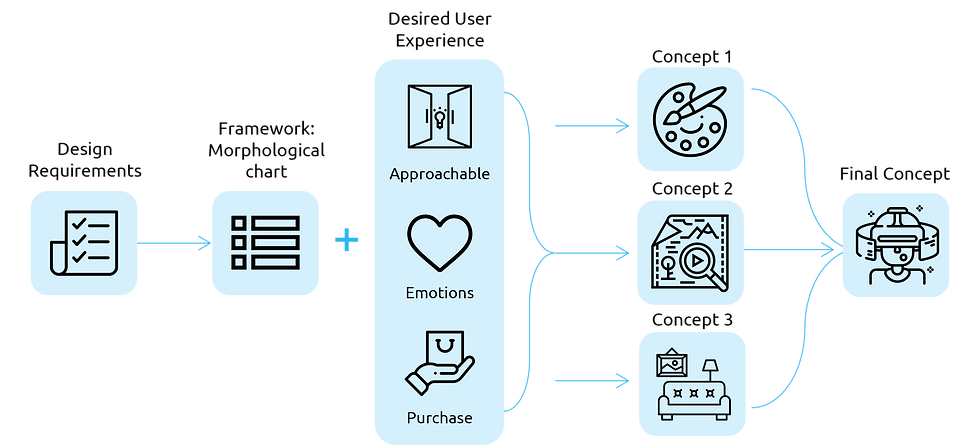
Conceptualization Strategy

For conceptualization, a co-creation session with three designers was conducted.
3.1. APPROACHABLE Concept 1: Stories behind the paintings
Since these are the interim concepts, to get a quick prototype, I prototyped them in 2D instead of 3D.
The first concept is called 'Stories Behind the Paintings'. It is focused on helping viewer to know the stories behind each artwork. When you take on the VR device, you will firstly see a virtual gallery similar to the real gallery.
3.2. EMOTIONS Concept 2: Adventurous Collection
One of the big barriers that many galleries can hardly attract visitors is their lack of interesting stimulations. Visitors couldn’t find many things that can stimulate their interests to explore in the current gallery for a longer time. Therefore,they always leave the gallery within five minutes, which lower the chance they will purchase. Hence this concept intensifies the emotions (amazement & curiosity) to continuing stimulates users’ interests to explore the virtual gallery.
3.3. PURCHASE Concept 3: Find your perfect art piece for your home!
Another important problem for current gallery is the low conversion rate. This was caused by various reasons: vague price, too high price, doesn’t know how to buy, doesn’t know
whether the art piece suits, etc. Many visitors visit the gallery without having intention to buy anything. Some of them may have the confusion on whether a gallery is a place to exhibit or to sell artworks. In this concept, it focuses on helping customers to find their suitable art piece for their home and encourage purchases. It is designed into an obvious commercial space that sells artworks, so that customers have the feeling that they are here to purchase.
3.4. Concepts Validation
Test Setup:
Duration: ±30 minutes
Concept test: C1, C2, C3
Participants: 10 people
Scenario: Visiting a gallery without purchasing plan
Materials: Paper prototypes, Sticky Notes, Miniature model of gallery, Phone for immersive video, VR Cardboard, questionnaire afterwards
Goal: To understand how intuitive each of the concepts are and what users like and dislike about them, in order to compare the three concepts.

Paper prototypes

Miniature model of the new gallery


Concept 1 and concept 3 both have a clear and logical narrative, and they are most related to purchasing artworks in virtual environment. They have different directions and focus points, which are both considered to be in line with the design goal. Therefore, most elements from these two concepts will be considered integrating into the final concept.
Although concept 2 were the most favourable concept, mainly because its interesting setting and attractive virtual environments. Users would pay more attention to enjoy the virtual environment and interactions, forgetting they were here to purchase some artworks.
3.5. Conceptualization – final concept elements
After analysis the results from evaluation, I concluded 6 elements that should exist in the final design concept:
Gallery-like environment
Training / warm-up session
360-degree video of artists
Explorative elements
A way they can see how the artworks look in a home environment rather than in the virtual gallery
The postcard including shopping information (post-experience service)
4. Prototyping
The process of prototyping includes 4 phases of below:

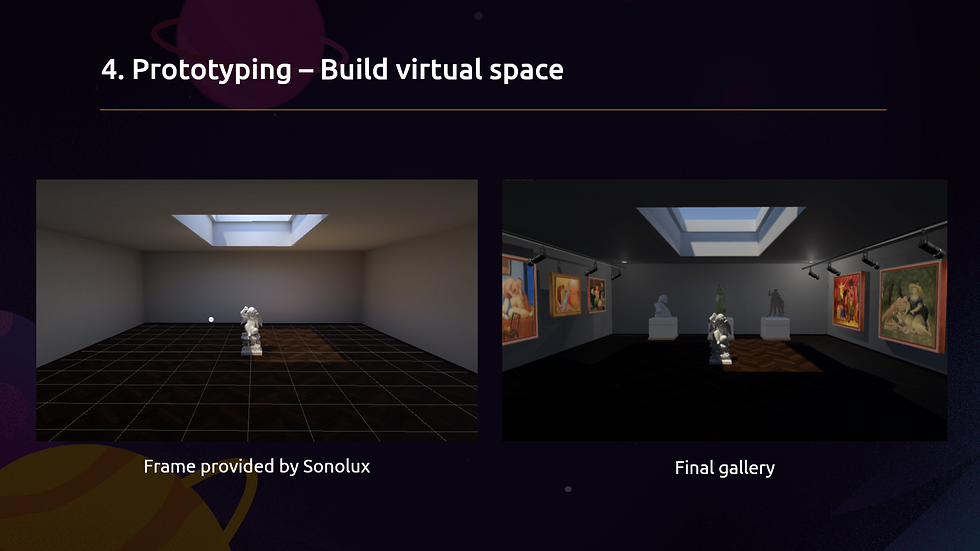
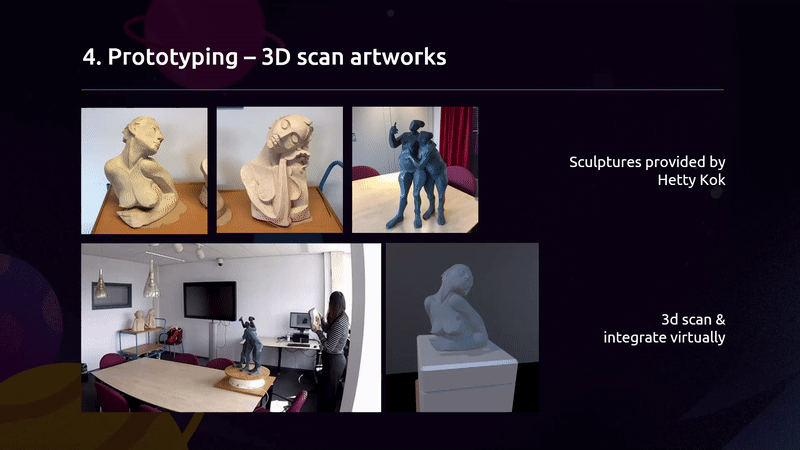
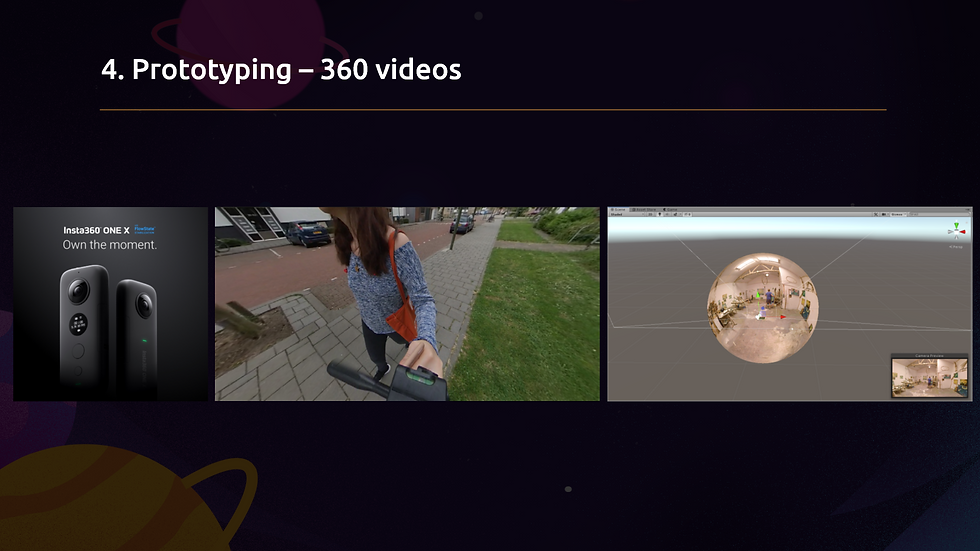
The final concepts were differentiate with 2 Gallery interactions.
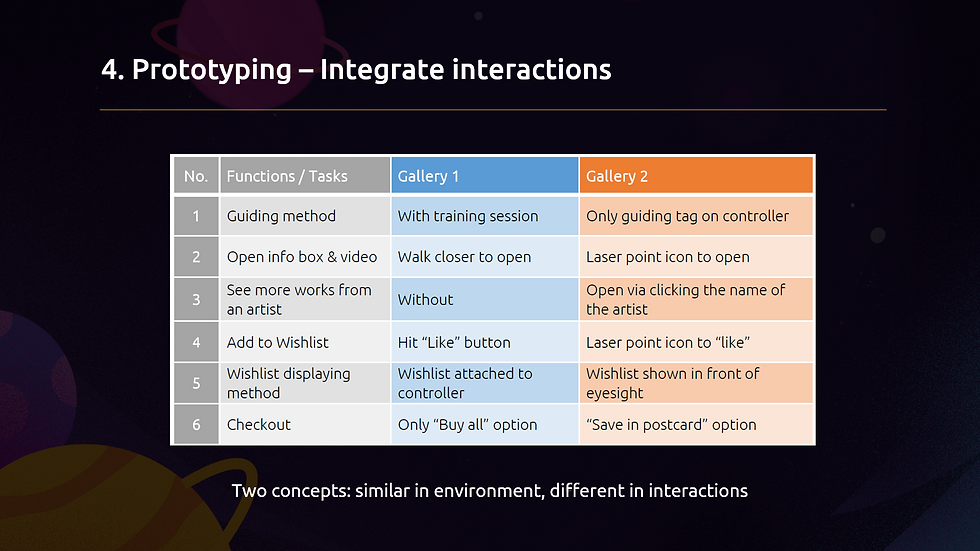

5. Evaluation
The evaluation phase consisted of two parts: The first one is evaluation on excluding
the VR home scene from the final concept. This was done because of the doubt of whether a home scene in VR gallery would help users make decisions to buy artworks. The result showed that An AR application would be more helpful than using the VR gallery.
The second evaluation is the user tests on the functional prototype of VR gallery. Two gallery concepts were developed, which were identical in the environment, but different from the interactions on performing six certain functions. The order of the testing galleries was random to prevent bias on one gallery. There were four parts of the analysis of the results. From the results, the VR gallery achieved the requirements of the desired experience to some extent.
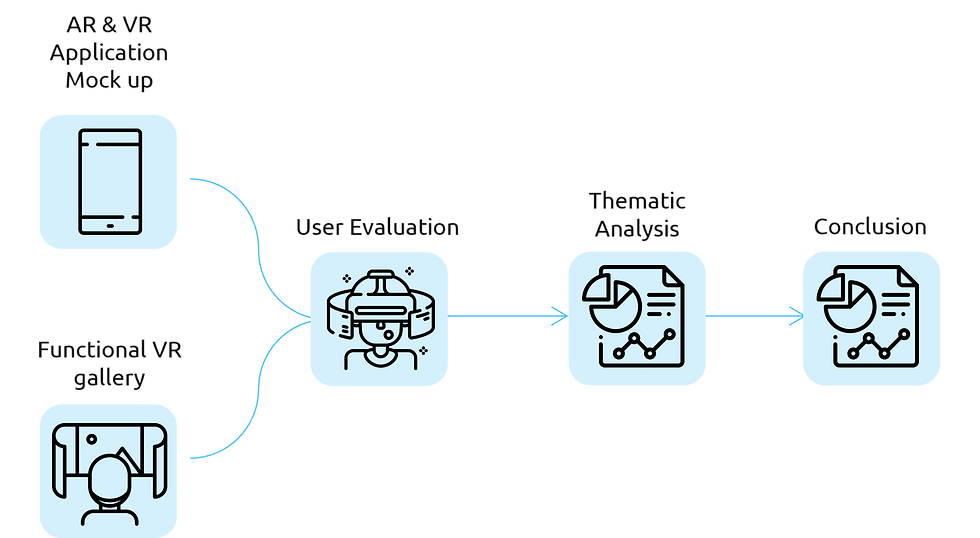
A within subject experiment was conducted. Which means each participant experience dboth concepts, the order was changed for half of them.

User Test
Participants: 8+1 Pilot
Age: 50% (20-25) + 50% (25-29) + Pilot (25-29)
Gender: 4 female + 4 male + 1 female pilot
Test duration: 40 ± mins
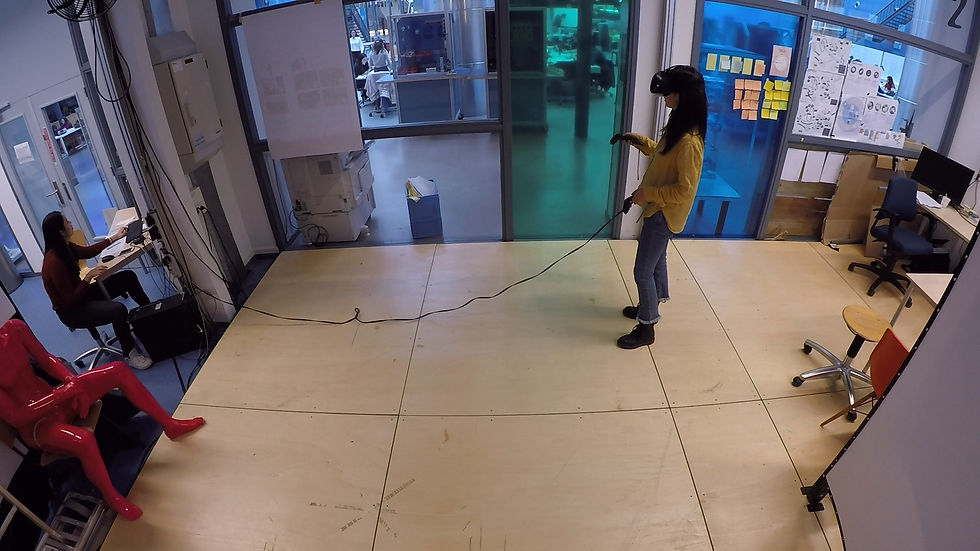

The participants were asked to fill in a questionnaire before and after the tests.

6. Conclusion
Looking back to the Desired Experience I wanted to achieve in the beginning:
The envisioned new gallery will offer a more approachable way of visiting a gallery. The novice art buyers should feel comfortable to enter the café-like gallery, where they can explore different forms of interactions with VR HMD devices to have continuous stimulation. Furthermore, after the experience, they should be motivated to spread the word. They should be offered possibilities to schedule next visit or glancing desired artworks online.
In conclusion, the VR gallery did offer a more approachable way of visiting a gallery, it gave the users opportunities to view artworks in different perspectives. Novice users are more encouraged to spend time in the gallery. The postcard and the AR app increased the possibility of making purchase decisions after visiting a VR gallery.
There are still steps need to be taken to complete the concept from both a technical perspective and a design perspective. Further developments and adjustments will enrich the user experience, and desired user experience can be realized better.
Limitation
Limited access to the real user group
Limitation of the design iteration and Validation
Limitation of the project scope
One of the obstacles in the project is to get in touch with the user group, especially for non-Dutch speaking people like the researcher. The VR gallery was designed mainly facing Dutch locals, therefore the research about galleries and user characteristics were mainly from literature reviews. Although inquiry research was conducted, the sample sizes were not big, and there was not much verbal communication with the gallery visitors due to the language barrier. The user profiles and storyboards can be more explicit and convincing if more people from the target group join in the research activity and provide detailed information about their purchasing behaviors.
Due to limitations in time and resources, it is not feasible to carry out a real gallery visiting experience for the design iteration and the evaluation of the final concept.
Instead, evaluation sessions with peer students and concept tests with users were conducted during the design stage to check the effect of certain features and people’s likelihood of use. User tests were conducted for the final evaluation. Although miniature models and introduction briefing can help the users understand the scenario better. The testing place is still different from a real pop-up gallery. The result of the final evaluation shows that the concept meets the design goal, but there are still things that need to be tested in a real-life context and during real experience.
For now, the project only focuses on the experience inside the VR gallery. However, when looking at the desired user experience, it’s not only about the experience in the virtual environment, but the whole journey of purchasing experience. This design should not be limited to the interactions in the virtual environment, it should be about every stage of visiting a gallery.
Recommendation
More guidance of use for better understandings
More artworks implemented and change over time to time
Consistent designs
More validations in real gallery
7. Reflection
An eye-open experience on art field
Personal vision on helping the traditional industry to adapt to the new digital world
Every small step counts
Unnecessary to present perfect prototypes
8. Video and Image Gallery


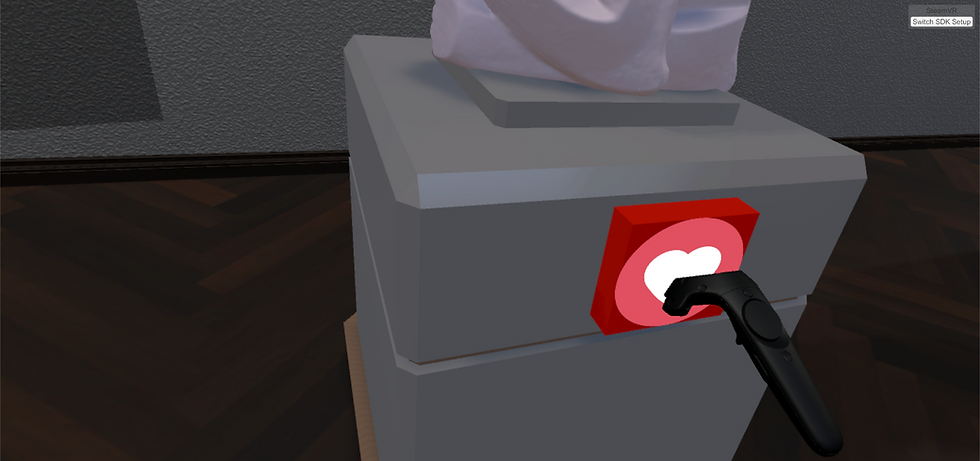

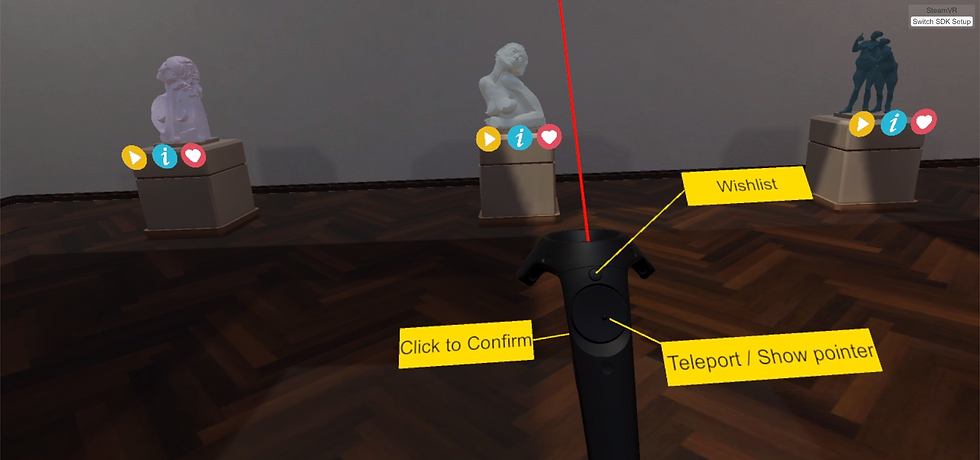
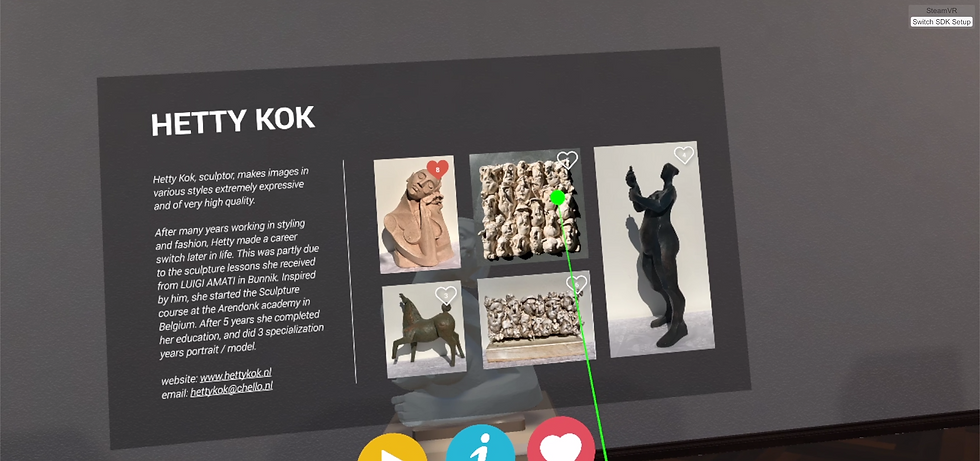
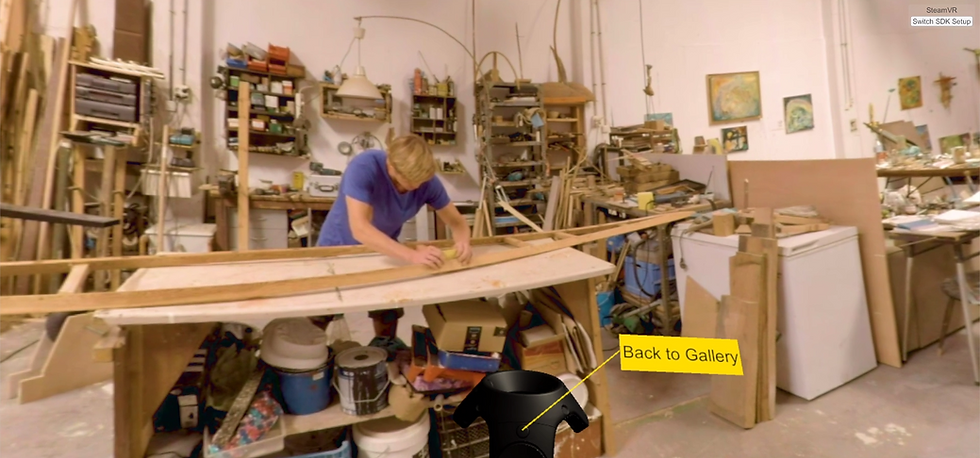


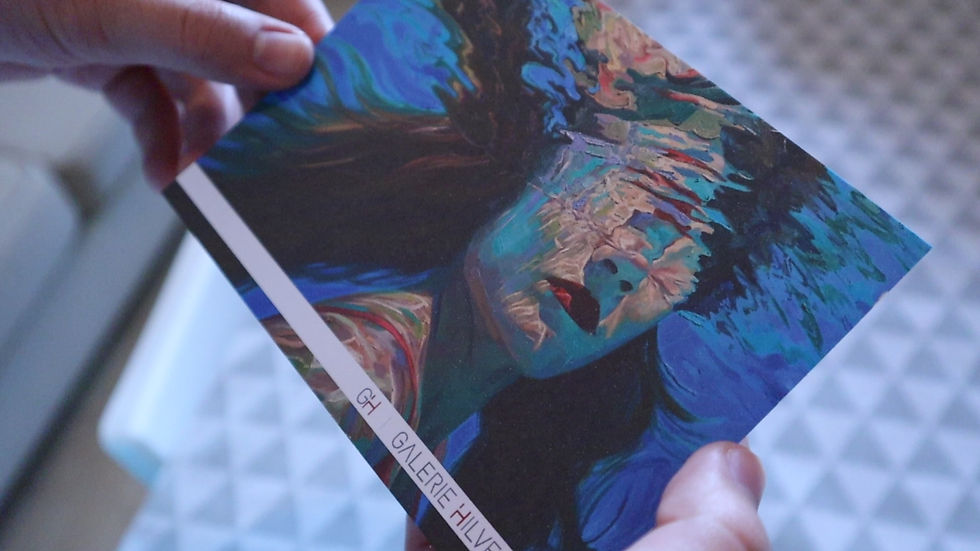

Full Thesis for Reading
Other Projects
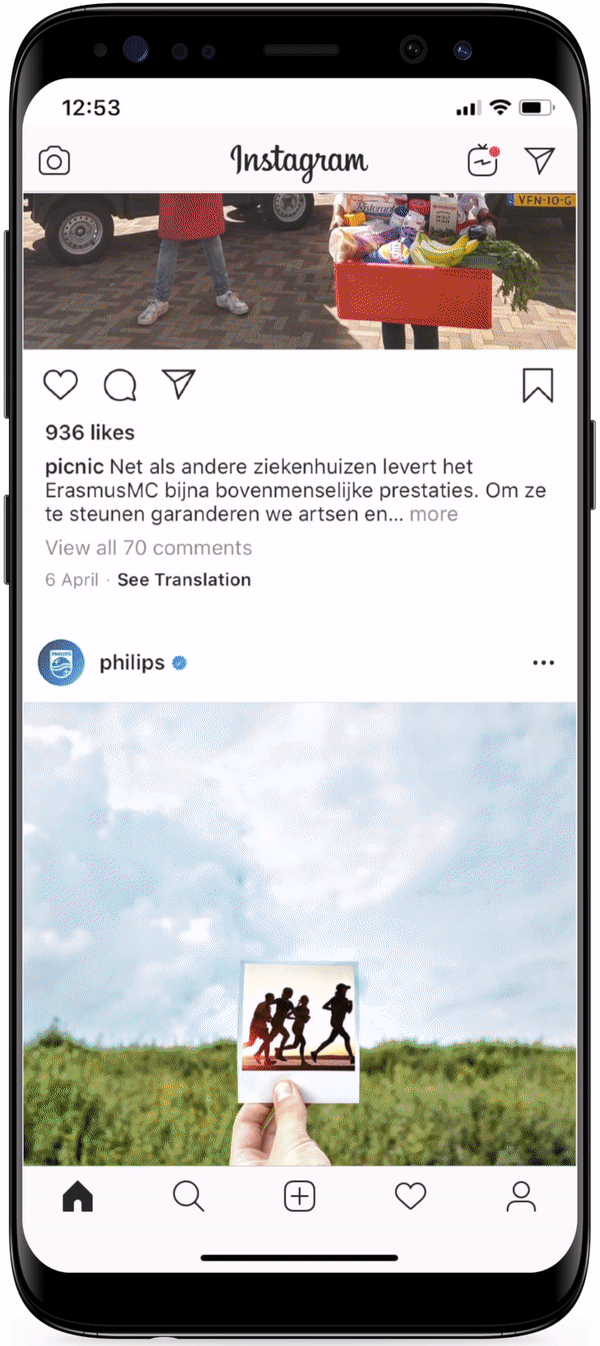
Interactive Prototypes for Prospective Clients
Created interactive prototypes and videos for prospective clients, to demo the possibility they could have with FF.ai.

Vegehood | 蔬户
Vegehood | 蔬户 provides urban nature learning experiences for urban families in China.